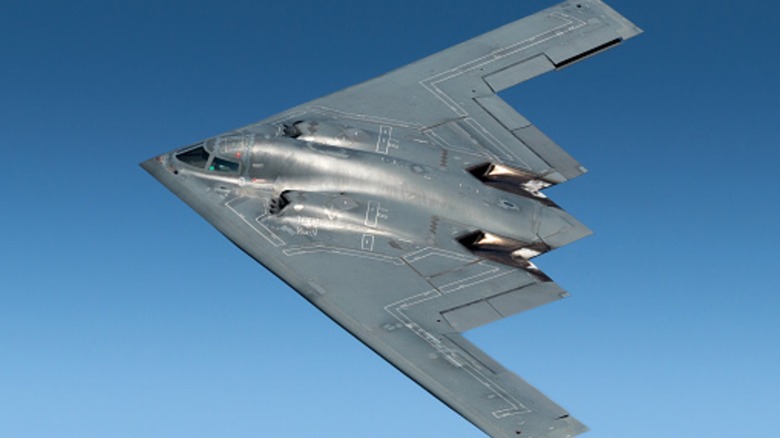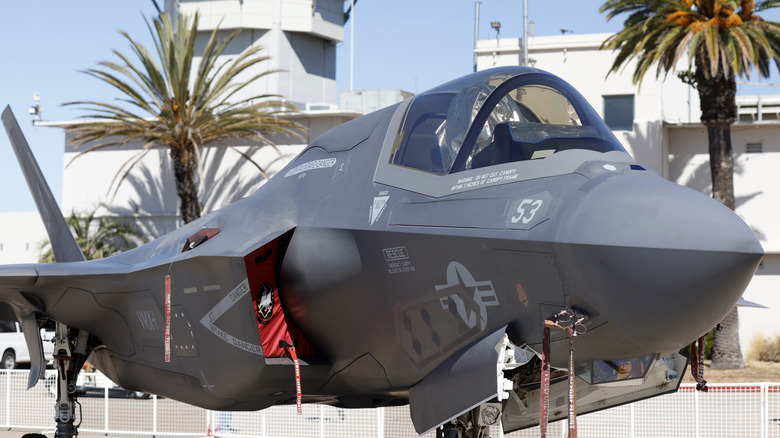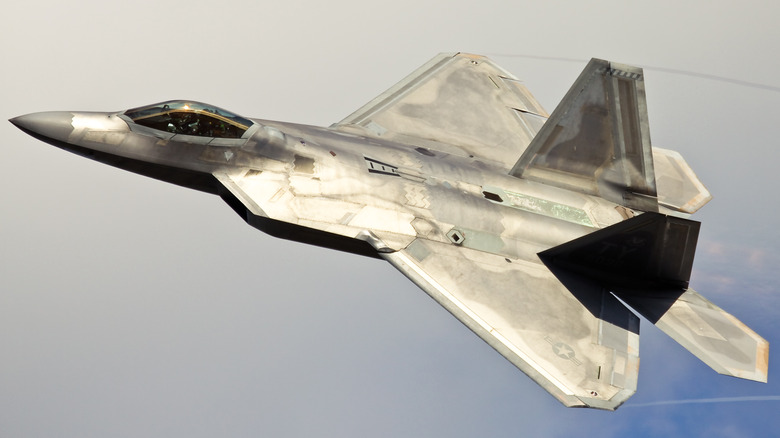How Stealth Aircraft Technology Has Evolved From The F-117 Nighthawk To The B-21 Raider
Stealth — or low-observable – technology used to be rare on aircraft, only seen on the F-117 Nighthawk and B-2 Spirit, but it's the defining feature of an entire generation of fighter jets like the F-22 Raptor and F-35 Lightning II. Compare the appearance of modern fifth-generation fighters to the Nighthawk and you see they don't look like a blocky contraption designed in Minecraft. The Nighthawk took all of its cues from a prototype aircraft named Have Blue in 1977, which was also boxy-looking. That's not by accident.
Radar transmitters send out bursts of radar waves and when they hit a conventional aircraft, it reflects the waves, alerting air control to its presence. However, the sharp angles and straight edges seen on the Nighthawk create a smaller cross-section, so they don't deflect radar waves directly back to radar receivers. The military tested this new low-observable aircraft in complete secrecy for eight years at the Tonopah Test Range in Nevada. There were periodic leaks, but it wasn't until 1990 that the U.S. Air Force officially acknowledged its existence, shortly after it took part in combat operations in Panama.
All the while, the Air Force and Northrop Grumman were hard at work improving the technology with the B-2 Spirit, a stealth bomber that didn't have the blocky look of its predecessor. Another change is the B-2's lack of vertical stabilizers, which gave it an even smaller radar cross-section. There's much more that goes into creating a stealth aircraft than its shape, though.
Features that improve stealth
The F-117 Nighthawk undeniably had a unique design. When other stealth aircraft appeared on the scene, the Nighthawk only stood out more. The B-2 shared few similarities, save for the paint scheme. The science behind stealth technology in military aircraft doesn't exclusively lay in their shapes. There are materials and paints that can significantly improve low-observability. Metals and carbons have to be used sparingly because of their electric conductivity. Fifth-generation jets like the F-22 are made out of a combination of titanium, composite materials, aluminum, and thermoplastic. There are also radar-absorbing materials manufacturers can coat the aircraft in.
These materials take the radar waves that hit the stealth aircraft and convert them into thermal or other forms of energy. Iron ball paint, for example, contains microscopic spheres of iron that resonate with the same frequency as a radar wave. It will absorb the wave and dissipate it. The signature that ends up bouncing back to a radar receiver is no bigger than a bird's or bumblebee's.
However, radar systems are evolving as well. What used to be known as single radar detection has transformed into multi-dimensional and multi-band radar networks, pushing researchers to find additional absorbing material beyond the traditional iron powder, ferrite, carbon fiber, and graphite. It's a constant battle of escalation, as with most technologies found on the battlefield. Quantum radar is a concept being worked on that can provide detailed information about the exact aircraft and missiles caught by the system.
Stealth aircraft today
The F-117 Nighthawk and B-2 Spirit bombers — despite its "F" designation, the F-117 Nighthawk was built as a bomber, not a fighter — were the only stealth planes for decades. Then the F-22 Raptor debuted in 1997, becoming the first real stealth fighter. Creating a low-observable jet includes hiding the pilot from radar, since the cockpit and its instruments add to the aircraft's radar signature. With the Nighthawk and B-2, the canopy was partly crafted out of low-observable material, but this limited the pilot's field of view. That's not as critical for a bomber, but fighter pilots need to retain situational awareness. Engineers coat the Raptor's canopy in a metallic radar-absorbing paint to reflect radar waves.
The F-35 Lightning II shares a lot of the Raptor's capabilities, including its blended and smoothed surfaces. Paul Poitras, director of survivability at Lockheed Martin's Skunk Works, told the Washington Post those surfaces "enable radar energy to smoothly flow across it—similar to water flowing across a smooth surface."
The next stealth aircraft to enter America's arsenal will be the B-21 Raider, a bomber that will replace the B-2 Spirit as well as the B-1 Lancer and kickstart the sixth-generation era. Not much is known yet about the new bomber's stealth capabilities, but it's smaller than the B-2, automatically giving it a tinier radar cross-section. And Northrop Grumman boasts that "next-gen stealth and advancements in low observable processes will make the aircraft easier and less costly to maintain."


